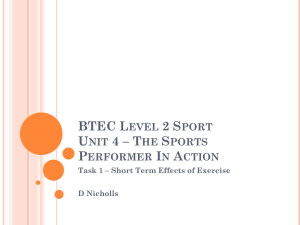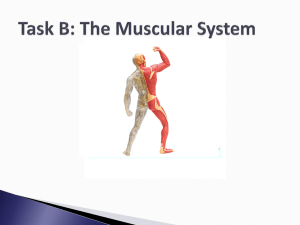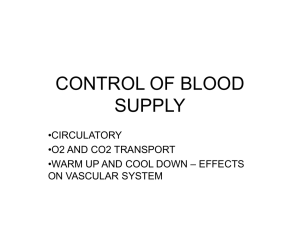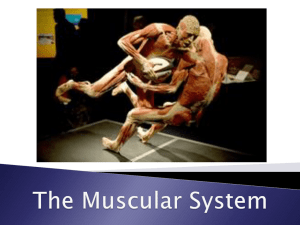PPT09Chapter9MusclarSystems
advertisement
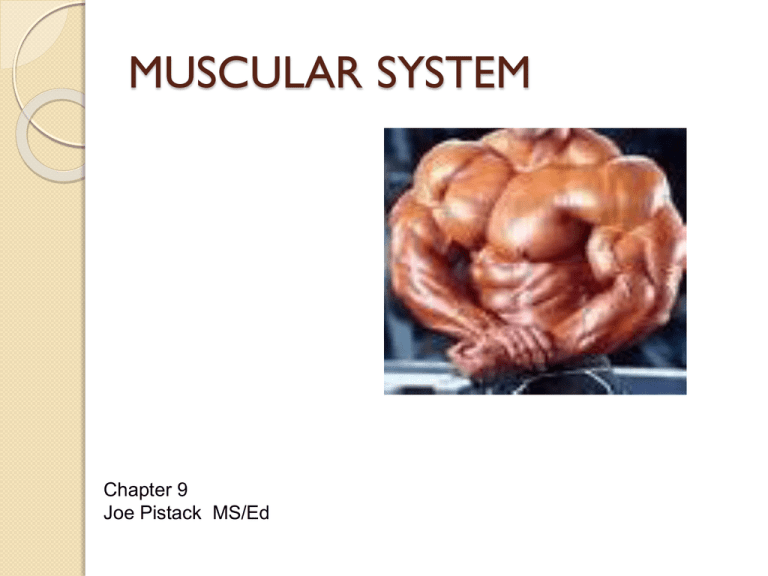
MUSCULAR SYSTEM Chapter 9 Joe Pistack MS/Ed MUSCULAR SYSTEM The word muscle comes from the Latin word muse, which means little mouse. When a muscle contracts, the muscle movement under the skin resembles the movement of the mice scurrying around. TYPES OF MUSCLES Three types of muscle: Skeletal Smooth cardiac SKELETAL MUSCLE -Generally attached to bone. -Voluntary musclecontrolled by choice. -Skeletal muscle cells are long, shaped like cylinders or tubes. -Appearance is striped or striated. SKELETAL MUSCLE Functions: Produce movement. Maintain body posture. Stabilize joints. Produce heat-helps to maintain body temperature. SMOOTH MUSCLE Generally found in the walls of the viscera. Found in the bronchioles and blood vessels. Involuntary-functions automatically. Does not appear striped or striated. (nonstriated) CARDIAC MUSCLE Cardiac Muscle-found only in the heart. Function-pumps blood throughout the body. Cardiac muscle is made of long branching cells that fit together tightly at junctions called intercalated discs. These discs promote the rapid conduction of electrical signals throughout the heart. LAYERS OF CONNECTIVE TISSUE Fascia-layers of tough connective tissue that surround large skeletal muscle. Epimysium-the outer layer of the fascia. Tendon-strong cordlike structure that extends toward and attaches to the bone. LAYERS OF CONNECTIVE TISSUE Perimysium-another layer of connective tissue, surrounds smaller bundles of muscle fibers. Fascicles-bundles of muscle fibers. Endomysium-third level of connective tissue the surround the individual muscle fibers. LAYERS OF CONNECTIVE TISSUE COMPARTMENT SYNDROME Compartment syndrome or crush syndrome, usually occurs from a crushing injury. ◦ Ex. Pinned between two automobiles. Usually occurs in the lower extremities. A normal limb has an extensive amount of fascia that separates the muscle into isolated compartments. COMPARTMENT SYNDROME Each compartment receives the blood vessels and nerves necessary for muscle function. In a “crush injury” the muscle is damaged, it becomes red and inflamed and leaks into the compartment. Pressure in the compartment increases and compresses the nerves and blood vessels. COMPRESSION SYNDROME The muscles and nerves begin to die due to lack of oxygen and nourishment. Immediate treatment involves reduction of the compartment pressure by slicing the fascia lengthwise. COMPARTMENT SYNDROME MUSCLE ATTACHMENT Muscles attach to other structures in three ways: (1)tendon attaches the muscle to the bone. (2)muscle attaches directly to the bone. (3)sheet like fascia called aponeurosis connects muscle to muscle or muscle to bone. STRUCTURE AND FUNCTION Actin and Myosin are two proteins that are necessary for the contraction of muscles. Sarcomere-contractile unit made up of myofibrils. Muscles can only pull, not push. When a muscle contracts it shortens. HOW MUSCLES CONTRACT Sliding filament theory-the interaction of actin and myosin sliding past each other causing the muscles to contract. ATP and calcium play an important role in the contraction and relaxation of muscles. SOMATIC MOTOR NEURON Motor or somatic nerve-nerve that supplies skeletal muscle so that muscle contraction can take place. A motor nerve comes from the spinal cord and supplies several muscle fibers with nerve stimulation. Neuromuscular junction (NMJ)-area where the motor nerve meets the muscle. MUSCLE STIMULATION Electrical signal is given muscle membrane. Triggers a series of events. Results in muscle contraction. DISORDERS OF NMJ Myasthenia Gravis-disease that attacks the neuromuscular junction. Symptoms-are due to damaged receptor sites on the muscle membrane. Muscle contraction is impaired and the person experiences extreme weakness. As the disease progresses, the person experiences difficulty breathing since breathing muscles are skeletal muscles. MYASTHENIA GRAVIS TETANUS Neurotoxins are transmitted by certain bacteria. Clostridium tetani secretes a neurotoxin that causes excessive firing of the motor nerves. Results in severs muscle spasm and tetanic contractions. RESPONSE OF WHOLE MUSCLE Single muscle fiber-contracts in an all-ornothing response. Whole muscle-capable of contracting partially, can contract weakly or very strong. ◦ Ex. Small force is necessary to lift a pencil, greater force is necessary for 100lb. Weight. RESPONSE OF A WHOLE MUSCLE Recruitment-the process of recruiting additional fibers to achieve a greater muscle force. Twitch-muscle contracts and then fully relaxes in response to a stimulus. Tetanus-if a muscle is stimulated immediately and has no time to relax it remains contracted. Sustained muscle contraction is called tetanus. MUSCLE TONE Tetanic muscle contractions play an important role in maintaining posture. The muscle being able to tetanize gives us an upright posture. TONUS Tonus-the normal continuous state of partial muscle contraction. Muscle tone in the smooth muscle of the blood vessels helps to maintain blood pressure. ENERGY SOURCE Muscle contraction requires a rich source of ATP for energy, it is consumed by contracting muscles and replaced by: (1)Aerobic metabolism (2)Anaerobic metabolism (3)Metabolism of creatine phosphate ORIGIN AND INSERTION Origin-attachment of the muscle to a stationary bone. Insertion-attaches to a movable bone. MUSCLE TERMS Prime Mover-”chief muscle”, a single muscle that is generally responsible for most of the movement. Synergists-”helper muscle”, works with other muscles. Antagonists-muscles that oppose the action of other muscles. MUSCLE TERMS Hypertrophyoveruse of a muscle, the muscles increase in size. ATROPHY Atrophy-wasting away or decrease in the size of a muscle, due to lack of exercise or use. CONTRACTURE Contractureabnormal formation of fibrous tissue within the muscle. Result of the muscle being immobilized for long periods of time. HOW MUSCLES ARE NAMED The names of skeletal muscles are generally based on one or more of the following: (1) size (5)number of origins (2)Shape (6)origin & insertion (3)direction of fibers (7)muscle action (4)location Muscles of the Head Grouped into 2 categories: (1) facial muscles (2)chewing muscles When facial muscles contract, they pull on the soft tissue. This muscular activity is responsible for smiling and frowning. Frontalis Muscle Flat muscle-covers the frontal bone. Extends from the cranial aponeurosis to the skin of the eyebrows. Contraction of this muscle raises your eyebrows. Gives us surprised look and wrinkles your forehead. Orbicularis Oculi Sphincter muscle that encircles the eye. Sphincter-ring shaped muscle that controls the size of an opening. Contraction of the muscle closes the eye and assists with winking, blinking and squinting. Orbicularis Oculi Orbicularis Oris Sphincter muscle that encircles the mouth. Contraction of this muscle assists in closing the mouth, forming words, and pursing lips. Kissing Muscle Kissing Muscle Buccinator Inserts into the orbicularis oris and flattens the cheek when contracted. Used in whistling and playing the trumpet. Considered the chewing muscle, on contraction it helps position food between the teeth for chewing. The Buccinator The Zygomaticus The smiling muscle. Extends from the corners of the mouth to the cheekbones. The Smiling Muscle Chewing Muscles Also called muscles of mastication(chewing). Inserted on the mandible, or lower jaw bone. Considered to be some of the strongest muscles in the body. Masseter Extends from the Zygomatic Process to the temporal bone in the skull to the mandible. Contraction of this muscle closes the jaw. Synergistically works with the other chewing muscles. Temporalis Fan-shaped muscle that extends from the flat portion of the temporal bone to the mandible. Works synergistically with other chewing muscles. The Temporalis Sternocleidomastoid Contraction of only one of the sternocleidomastoid muscles causes the head to rotate toward the opposite direction. Torticollis or wryneck is a spasm of this muscle. Characterized by twisting of the neck and rotation of the head to one side. Sternocleidomastoid Extends from the sternum and clavicle to the mastoid process of the temporal bone in the skull. Contraction of both muscles on either side of the neck causes flexion of the head. The head bows as in prayer, called the Praying Muscle. Sternocleidomastoid Trapezius Origin is at the base of the occipital bone in the skull and to the spine of the upper vertebral column. Trapezius Origin is at the base of the occipital bone in the skull and to the spine of the upper vertebral column. Contraction of the trapezius allows the head to tilt back so that the face looks at the sky. Works antagonistically with the sternocleidomastoid muscle, which flexes and bows the head. Also attached to and moves the shoulder. Trapezius Muscle Muscles of the Trunk Functions of the trunk muscles: Involved in breathing. Form the abdominal wall. Move the vertebral column. Form the pelvic region Muscles Involved In Breathing Intercostal muscles – located between the ribs and are responsible for raising and lowering the rib cage during breathing. External and Internal Intercostals musclesare attached to the rib cage. Diaphragm Dome-shaped muscle that separates the thoracic cavity from the abdominal cavity. Chief muscle of inhalation. Breathing cannot occur without the contraction and relaxation of the intercostal muscles and the diaphragm. Muscles That Form The Abdominal Wall The abdominal wall consists of four muscles in an arrangement that provides considerable strength. Muscles are layered so that the fibers of each of the four muscles run in four different directions. The arrangement enables the muscles to contain, support, and protect abdominal organs. Muscles of The Abdominal Wall The abdominal muscles also cause flexion of the vertebral column and compression of the abdominal organs during urination, defecation, and childbirth. The four abdominal muscles include: Rectus abdominis External oblique Internal oblique Transverse abdominis Rectus Abdominus Fibers run up-anddown or longitudinal direction. Extends from the sternum to the pubic bone. Contraction of this muscle flexes, or bends the vertebral column. External Oblique Make up the lateral walls of the abdomen. The fibers run obliquely or slanted. Internal Oblique Part of the lateral walls of the abdomen. Adds to the strength provided by the external oblique muscles, as fibers of the oblique muscles form a crisscross pattern. Transverse Abdominis Form the innermost layer of the abdominal muscles. The fibers run horizontally across the abdomen. Abdominal Muscles Linea alba – white line, an aponeurosis of the abdominal muscles on the opposite sides of the midline. Extends from the sternum to the pubic bone. Muscles of the Shoulder and Upper Arm Trapezius – attaches to the base of the occipital bone, thoracic vertebrae, and scapula. When contracted, shrugs shoulders. Gets its name because the right and left trapezius form the shape of a trapezoid. Trapezius Muscle Serratus Anterior Located on the sides of the chest and extends from the ribs to the scapula. Has a jagged shape, like the edge of a serrated knife. Serratus Anterior When the serratus anterior contracts, the shoulders are lowered and the upper arm moves forward as if pushing a shopping cart. The trapezius and the serratus anterior attach the scapula to the axial skeleton. Pectoralis Major Large, broad muscle that helps to form the anterior chest wall. Connects the humerus with the clavicle and structures in the anterior chest. Pectoralis Major Contraction of the pectoralis major moves the upper arm across the front of the chest as in pointing to an object in front of you. Latissimus Dorsi Large, broad muscle located in the middle and lower back region. Extends from the back structures to the humerus. Latissimus Dorsi Contraction of the latissimus dorsi muscle lowers the shoulders and brings the arm back as in pointing to an object behind you as in swimming or rowing. The Deltoid Forms the rounded portion of your shoulder; your shoulder pad. Extends from the clavicle and scapula to the humerus. The Deltoid Contraction of the deltoid muscle abducts the arm, raising it to a horizontal position, the scarecrow position. Common site of intramuscular injections. Rotator Cuff Muscles Group of 4 muscles that attach the humerus to the scapula. These muscles make up the Rotator Cuff They include: (1) Subscapularis (2) Supraspinatus (3) Infraspinatus (4) Teres Minor Rotator Cuff Muscles The tendons of these four muscles form a cap or a cuff over the proximal humerus, this stabilizes the joint capsule. The rotator cuff muscles help to rotate the arm at the shoulder joint. Rotator Cuff Muscles Rotator cuff injury or impingement syndrome is caused by repetitive overhead motions, common in athletes and causes shoulder pain. The tendons are pinched and become inflamed resulting in pain. If the condition continues the inflamed tendon can degenerate and separate from the bone. Rotator Cuff Muscles Muscles That Move The Lower Arm Triceps brachii – lies along the posterior surface of the humerus. The origin is the scapula and the insertion is the olecranon of the ulna. Triceps Brachii The triceps brachii is the muscle that supports the weight of the body when a person does a pushup or walks with crutches. Muscle that packs the greatest punch for a boxer, called the boxer’s muscle. Biceps Brachii Located along the anterior surface of the humerus. Origin is the scapula and the insertion is the radius of the forearm. Brachialis and Brachiordialis Act synergistically with biceps brachii to flex the forearm. The biceps brachii and the brachialis are the prime movers for flexion of the forearm. Biceps Brachii Biceps brachii is the muscle that is most visible when someone is asked to “make a muscle”. Muscles That Move The Hands and Fingers More than 20 muscles move the hands and fingers. Enable the hands and fingers to perform delicate movements. The muscles are generally located along the forearms. Muscles That Move The Hands and Fingers Flexors are located on the anterior surface. Extensors are located on the posterior surface. Tendons of these muscles pass through the wrist into the hand. Contraction of the muscles in the forearm pull on the tendons thereby moving the fingers. (like puppet strings) Carpal Tunnel The flexor tendons in the carpal tunnel (wrist area), are encased in tendon sheaths and normally slide back forth easily. Repetitive motion of the hand and fingers can cause the tissues within the carpal tunnel to become inflamed and swollen. Carpal Tunnel The swelling puts pressure on the median nerve, which is located in the carpal tunnel. The irritated nerve causes tingling, weakness, and pain in the hand. Pain may radiate to arm and shoulder. This is called carpal tunnel syndrome. Carpal Tunnel Syndrome Gluteal Muscles Located on the posterior surface: The gluteal muscles include: (1) Gluteus Maximus (2) Gluteus Medius (3) Gluteus Minimus Gluteus Maximus Largest muscle in the body. Forms the area of the buttocks. Muscle that you sit on. Straightens or extends the thigh at the hip as you climb the stairs. Gluteus Medius Lies partly behind and superior to the gluteus maximus. Gluteus Muscles Iliopsoas Located on the anterior surface of the groin. Contraction of this muscle flexes the thigh, making it antagonistic to the gluteus maximus. Adductor Muscles Located on the inner surface of the thigh. Adducts the thighs by pressing them together. (muscles that hoarse riders use to stay on horse) Include: adductor longus, adductor brevis, adductor magnus, and gracilis. Quadraceps Femoris Most powerful muscle in the body. Located on the anterior thigh and is the prime mover of knee extension. Contains 4 heads (points of attachment): (1) Vastas lateralis (2) Vastas intermedius (3) Vastas Medialis (4) Rectus Femoris Quadriceps Femoris The quads straighten or extend the leg at the knee as in “kicking a football”. Flexes the thigh at the hip joint. Vastas lateralis is used as an IM injection site. Sartorius Longest muscle in the body. Strap like muscle located on the anterior surface of the thigh. Allows the leg to rotate so that you can sit crossed-leg. Hamstring Muscles Group of muscles located on the posterior surface of the thigh. All muscles extend from the ischium to the tibia. Flex the leg at the knee, antagonistic to the quadriceps femoris. Hamstring Muscles Strong tendon of these muscles can be felt behind the knee. Popliteal fossa –where the tendons form a pit behind the knee. Hamstring muscles include: biceps femoris, semimembranosus, semitendinosus. The Hamstring Muscles Tibialis Anterior Located on the anterior surface, causes dorsiflexion of the foot. Peroneus Longus Located on the lateral surface, everts the foot (turns outward). Supports the arch of the foot and assists in plantar flexion. Gastrocnemius and Soleus Major muscles on the posterior surface of the leg and form the calf of the leg. Contraction of these muscles causes plantar flexion. Aids in walking and allows us to stand on tiptoe, called the dancer’s muscle. Disorders Of The Muscular System Fibromyositis – also called a charley horse. Pain and tenderness in the fibromuscular tissue of the thighs usually due to muscle strain or tear. Cramp – a painful, involuntary skeletal muscle contraction. Flatfoot – abnormal flatness in the sole and arch of the foot. Disorders Of The Muscular System Frozen shoulder - shoulder becomes stiff and painful making normal movement difficult. Often caused by disuse of the shoulder due to injury or pain associated with bursitis. Hypertonia – increased muscle tone causing spasticity or rigidity. Disorders Of The Muscular System Hypotonia – decrease in or absence of muscle tone, causing loose, flaccid muscles. Myalgia – pain or tenderness in the muscle. Myopathy – any disease of the muscles, not associated with the nervous system. Characterized by muscular degeneration.

